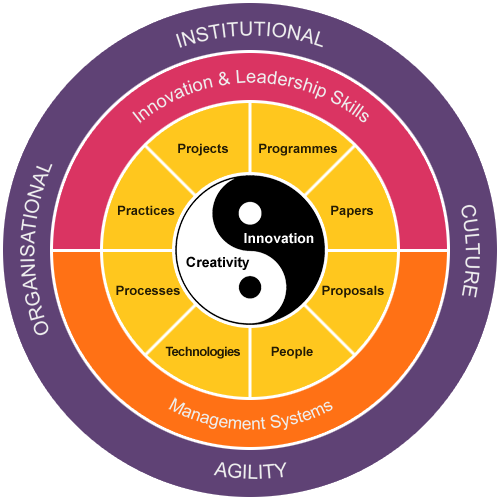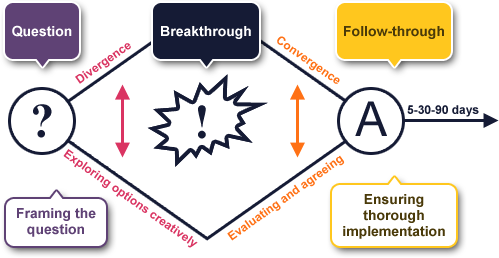Concept
The i-lab@HE concept
is based on some development work by Dr
Tom Kennie of Ranmore. Tom is active as a consultant and leadership
developer in the HE sector and some background information about
him can be found in here. In essence he describes the concept as
follows;
"the days when the senior team of any organisation could identify the
big breakthrough ideas which enable it to sail effortlessly through stormy
waters are swiftly declining. Competition is increasing, big ideas often
demand big investment and the senior team is not the only source for bright ideas."
- i-lab@HE is an opportunity to experiment with a different paradigm. An approach which combines creative problem solving, collaborative team working within an inclusive, more 'open space' type environment.
- i-lab@HE does not aim to identify 'the big idea' (although it might emerge) but rather it aims to nurture and foster the development of many, many innovative ideas - one or more of which may become 'the big idea'.
- i-lab@HE explores innovation through several different lenses as outlined by several seminal authors ranging from understanding the differences between sustaining and disruptive innovation as developed by Christensen et al (1997, 2003, 2009, 2011) to developing a discipline to the process of translating knowledge into tangible outputs which can be further developed into new products or services (Drucker, 2002 and Bettencourt and Bettencourt, 2011), through to creating catalysts to innovation (Martin, 2011) through to the process of management innovation as described by Hamel (2006,) among many other authors and contributions.
- i-lab@HE events are each unique, whilst designed around a core set of processes and facilitated activities, the focus and outcomes are all distinctive.
- i-lab@HE events can be created for modest group sizes (up to 20) right up to whole unit events involving 100 or more people.
In broad terms, an i-lab@HE process is designed to enable teams to;
- Identify, test and refine new innovative ideas which will improve their organisational performance,
- Engage, encourage and energise the team to experiment beyond current ways of working, and
- Create collective commitment to new ideas and ways of operating.
 Some Components of the i-lab@HE Experience
Some Components of the i-lab@HE ExperienceThe diagram above outlines the various levels at which the process operates,
building, over time a new language and approach to innovation.
The process is also designed to help leadership teams frame the priority questions on which to focus their energy, help them as they grapple with the initial complexity and options and move through to the development of agreed plans for action over short periods of time. In the midst of this the process also helps create the conditions by which staff are encouraged to constructively and creatively promote ideas which may lead to new and innovative breakthrough options to what may appear to be intractable issues. The diagram below illustrates the stages associated with the process.
 Stages associated with the i-lab@HE Process
Stages associated with the i-lab@HE ProcessSummary
i-lab@HE is a novel and new approach to developing leaders and teams in the critical capabilities of creativity and innovation. It can operate at several levels; at a
- individual level to provide feedback and insights about our capacity and capabilities in relation to creativity and innovation;
- team level to recognise and value the diverse talents and creativity to be found in teams; and
- institutional level to build the leadership capacity, the management processes and the right conditions which foster and develop a culture which truly values and encourages the practice of innovation.
Next Steps
To discuss the ideas and to explore how it might be relevant to your institution
please contact Tom Kennie on
01483 283040 or
email tkennie@ranmore.co.uk.
References
Bettencourt L. A. and Bettencourt S. L. 2011. Innovating on the Cheap. Harvard Business Review. June, pp 88-94.
Christensen C. 1997. The Innovator's Dilemma, HBS Press, 287pp.
Christensen C. and Raynor M. 2003, The Innovator's Solution, HBS Press, 304pp.
Eyring H.J. and Christensen C. 2011. The Innovative University: Changing the DNA of Higher Education from the Inside Out. HBS Press, (in press).
Drucker P. 2002. The Discipline of Innovation. Harvard Business Review. August, pp2-7.
Dyer J.H. Gregerson H.B. and Christensen C. 2009. The Innovator's DNA. Harvard Business Review. December, pp2-8.
Hamel G. 2006. The Why, What and How of Management Innovation. Harvard Business Review. February pp2-12.
Martin R.L. 2011. The Innovation Catalysts. Harvard Business Review, June, pp 82-87.